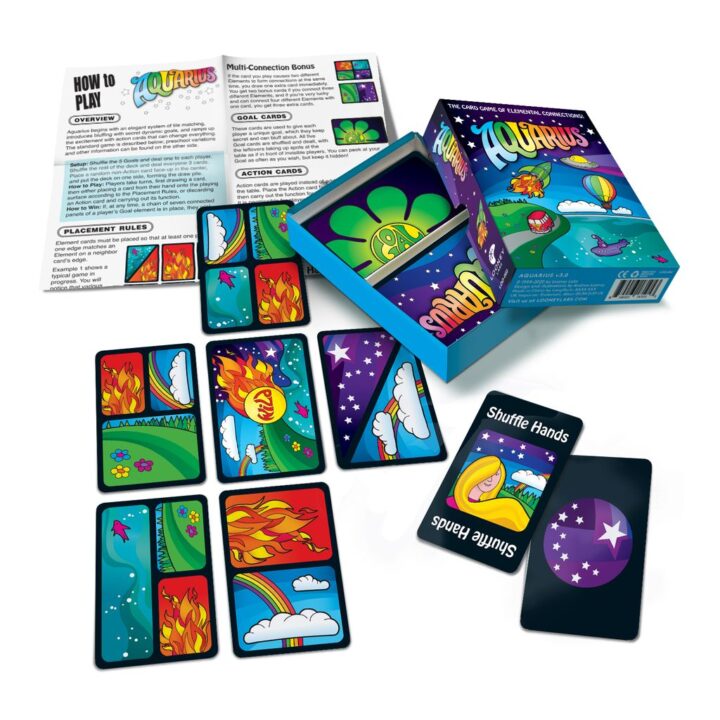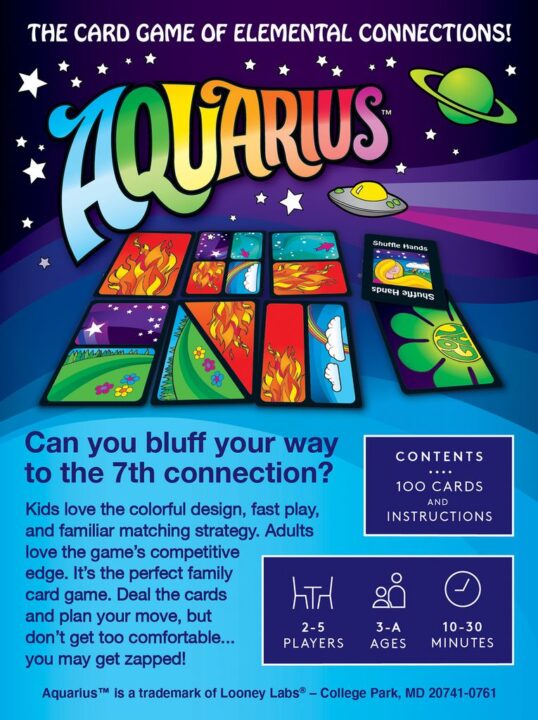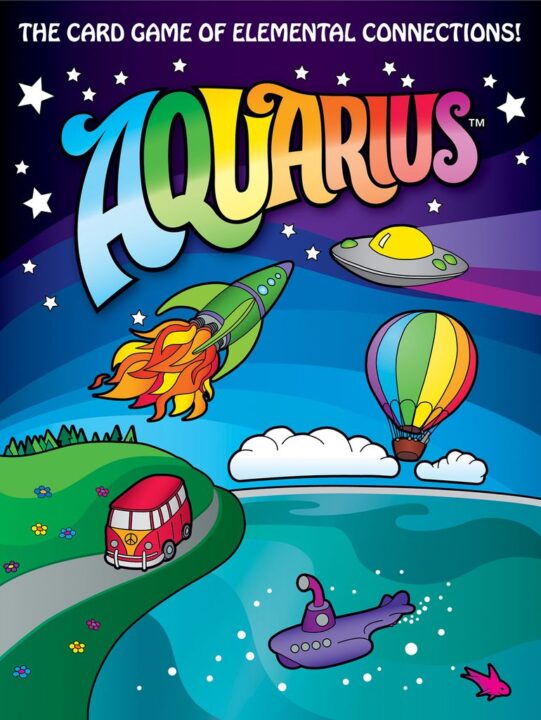Welcome to my review of the only board game that’s ever made me yell, “That’s not fair!” more than my younger cousin at family game night. Yes, I’m talking about Aquarius, a game that promises trippy artwork, wild fun, and more chaos than dodging Lego bricks in the dark. If you like fast, colorful games with lots of player interaction and just a pinch (or a bucket) of luck, stick around—because I’ve played this with my friends, and boy, do I have stories.
How It Plays
Setting Up
Shuffle all the cards and deal one secret goal card to each player. This tells you which element you want to match. Place the rest of the deck within grabbing distance. Give everyone three cards. That’s it—you’re ready!
Gameplay
On your turn, add one card to the table by matching at least one element with existing cards. Elements are like fire, water, earth, air, and space—basically all the things you’d find at a disastrous science fair. Watch out for action cards! They let you swap goals, trade cards, or rearrange stuff, so chaos is pretty much guaranteed.
Winning the Game
The first player to connect seven panels of their secret element wins. It’s a race, but other players will mess with your plans. Get ready to see your beautiful element chain get destroyed just when you think you’re about to win.
Want to know more? Read our extensive strategy guide for Aquarius.
Unpredictable Gameplay and Sneaky Player Interaction in Aquarius
Let me set the scene. It’s Friday night. My friend Dave is already shuffling Aquarius cards while pretending he can’t see the one up his sleeve. Welcome to the gameplay of Aquarius, where chaos and laughter reign.
The mechanics of Aquarius are simple, but don’t be fooled—simple doesn’t mean boring. Each player gets a hidden goal card (like Water, Earth, or Fire) and you’re off trying to connect seven panels of your element. But if you think you’ll get there in peace, you haven’t met my cousin Carl. The deck is packed with special action cards that let you swap goals, rearrange cards, or take sneaky peeks. At any moment, the board can shift like a caffeinated river otter, and your dreams of victory vanish into thin air. Trust issues? Play Aquarius and discover how deep they go.
What really shines in Aquarius is the player interaction. You can feel the tension over every card played. Do you help yourself or block someone else? The table talk is wild, and so are the alliances—one second, you’re best mates, the next, you’re sworn enemies because someone swapped your precious water goal for boring old Earth. Just be ready for lots of groans, cheers, and the occasional fake cry for mercy. The downside? Sometimes luck decides who gets the perfect card, and strategy goes out the window faster than Dave stuffing the leftover pizza in his backpack.
So sure, Aquarius is a bit swingy, but it keeps everyone at the table involved. Now, brace yourself—next up, we’re talking about artwork and card quality, and trust me, you’re gonna want your sunglasses.

Bright Colors and Swirly Vibes: Artwork and Card Quality in Aquarius
If you ever wanted to be smacked in the face by a rainbow, Aquarius is your game. The cards burst with colors that could make a unicorn jealous. Even my friend Dave—who wears nothing except black and beige—said, ‘Whoa, that’s a lot.’ Every card is coated in swirling patterns and trippy artwork, and I swear playing Aquarius on a sunny patio almost got me a sunburn from sheer reflectivity.
The cards themselves feel sturdy. They’re glossy but not too slippery, so there wasn’t a single waterfall of cards onto the floor (that record still belongs to another game which will not be named here for legal reasons and my pride). I’ve played about ten games, and the cards still look pretty fresh—except for the one that my cat tried to eat, but that’s really on me for leaving the game box open.
The symbols for the elements are simple and bold. Even my color-blind friend managed just fine, so that’s a huge win for accessibility. It makes it easy to check what’s on each card even when my eyes are watering from laughter—or possibly eyestrain from the bright palette.
Now, I do wish the box included some way to organize the cards after play, maybe a card divider or something. But honestly, it’s a minor gripe, since shuffling them together in a pile adds to the game’s wild energy.
So, if you like your games with a side of retina-sizzling art and solid cards, Aquarius delivers. But let’s not get lost in the colors—we’ll see soon how long a game of Aquarius will tickle your brain and whether you’ll be reaching for the box again and again!

How Long Does a Game of Aquarius Really Take? (And Will You Want to Play Again?)
Alright, let’s get into the nitty-gritty: the length and replay value of Aquarius. Picture this: you’re settling down for a quick game night with your friends, snacks in hand. That’s exactly what Aquarius delivers. Most games wrap up in about 20 minutes—not so long that Uncle Jerry starts snoring, but not so quick that you feel cheated out of your chips and salsa. It’s one of those rare games you can play multiple times back-to-back without feeling like your brain is melting.
What keeps Aquarius coming back to my table is its replay value. The hidden goals give you a reason to play again—and again—since you’re always trying to bluff, mislead, and outsmart everyone else. Plus, the board (okay, the table) layout changes every single time, because you’re building a colorful tangle of cards that looks more and more like my sock drawer after laundry day. Sometimes you win in a flash, sometimes you claw your way back from the brink. It all depends who you’re playing with (I’m looking at you, Sarah, the master of chaos).
Whether it’s a family night, a filler between longer games, or the main event at a party, there’s enough wild twists in Aquarius to keep everyone on their toes. But, is it all luck, or is there some sneaky strategy hiding beneath those psychedelic cards? Next up, let’s crank up the tension as we break down the age-old battle of luck versus strategy in Aquarius!

Luck vs Strategy: Can You Outsmart Aquarius?
Let’s get real about Aquarius: you need both luck and some tricksy tactical skills if you want to win. At my last game night, my pal Jess somehow managed to win just by flipping the right card at the right time—twice! The rest of us just glared at her. But that’s Aquarius. You might lay out the perfect plan, only to watch it go up in smoke after someone plays a Zap card or swaps your goal. It feels a bit like being in a water balloon fight—fun, unpredictable, and someone always ends up soaked.
Now, don’t get me wrong. There’s room for clever play. You can block someone’s flow by tossing a wild card right in the middle of their perfect stream. You can swap goals if you think someone’s about to win, or be sneaky and hide what you’re really trying to do. But if the deck isn’t on your side, you might just have to watch in horror as your plans swirl down the river. This isn’t chess. Sometimes winning just means you got lucky with the cards—and then you’ll have to listen to Dave brag about it until next game night.
If you hate games decided by fate, Aquarius might frustrate you. But if you like some chaos and laughs with friends, it’s a splashy little game. For me, it’s a “yes,” but with a warning: bring your sense of humor and maybe a towel.
Conclusion
So, that wraps up my review of Aquarius! If you want a fast game filled with wild colors and even wilder card-swapping, this one’s for you. The artwork is groovy, the cards hold up to sticky pizza hands, and every round feels different thanks to chaotic interaction. But be warned—luck has a big say here. If you crave deep strategy, Aquarius might leave you shaking your head, like my buddy Sam after he lost three times in a row to sheer dumb luck. Still, it’s a laugh riot with the right crowd. I give it 3 out of 5 stars—fun, flashy, and just unfair enough to keep things interesting. Thanks for reading, and may your elements always align!

